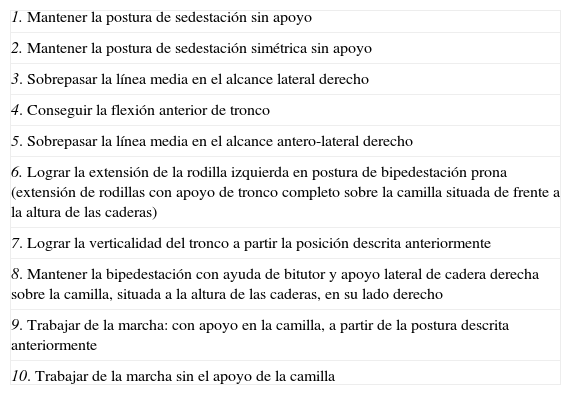El «síndrome del empujador» es un síndrome poco conocido que aparece tras sufrir un accidente cerebrovascular (entre el 10 y el 35% de los casos). Su presencia dificulta la recuperación ya que el paciente considera su cuerpo vertical cuando está inclinado unos 20° hacia el lado pléjico.
Antecedentes y objetivoSe trata de exponer el caso de una mujer, residente en un centro de personas mayores, que presenta dicho síndrome tras un accidente isquémico de la arteria cerebral media derecha.
Descripción del casoMujer de 81 años, diestra, autónoma para la marcha previamente a la lesión. Tras la lesión, se enfrenta a una situación de dependencia, con graves alteraciones posturales.
IntervenciónDespués conocer el síndrome que presenta, se comienza un tratamiento de fisioterapia, en el que se tienen en cuenta las características del síndrome. Se trabaja el alineamiento corporal y la carga de peso en el hemicuerpo derecho, a través de actividades significativas para ella.
ResultadosSe evidencia eficacia del tratamiento, utilizando 3 escalas que miden la gravedad del síndrome.
DiscusiónSe concluye que hacen falta más estudios para la comprensión profunda de los mecanismos lesionales y la adaptación del tratamiento.
ConclusiónSe evidencia la importancia del conocimiento de las características del síndrome por parte del fisioterapeuta y del equipo de atención directa, así como de la familia, para realizar un tratamiento eficaz.
The “pusher syndrome” is a very uncommonly known syndrome that appears after an ischemic attack (in 10 and 35% of the cases). Its presence hinders recovery since the patient feels as though his/her body is in a vertical position even when it is leaning about 20° towards the hemiplegic side.
History and objectiveA case report is presented of a woman residing in a residence for the elderly who suffered from pusher syndrome after an ischemic attack of the right middle cerebral artery.
Case descriptionAn 81 year-old female, right-handed, who was self-sufficient for walking prior to her stroke. Since the stroke, she has had to cope with being dependent and has severe postural alterations.
ProcedureFollowing the diagnosis of this syndrome, physiotherapy was initiated, taking the syndrome characteristics into account. Work has been done on body alignment and weight-bearing on her weaker side, using activities that were important for the patient.
ResultsTreatment efficacy has been observed through three scales measuring the syndrome severity.
DiscussionMore studies need to be carried out to obtain greater understanding of the injury mechanisms and adaptation to the treatment.
ConclusionThe paramount importance for the physiotherapist, the direct care team and the family to be knowledgeable regarding the features of this syndrome to carry out an efficient treatment is clear.
Artículo
Si ya tiene sus datos de acceso, clique aquí.
Si olvidó su clave de acceso puede recuperarla clicando aquí y seleccionando la opción "He olvidado mi contraseña".Comprando el artículo el PDF del mismo podrá ser descargado
Precio 19,34 €
Comprar ahora








